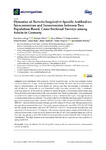2020-11-25Zeitschriftenartikel
Dynamics of Borrelia burgdorferi-Specific Antibodies: Seroconversion and Seroreversion between Two Population-Based, Cross-Sectional Surveys among Adults in Germany
Woudenberg, Tom
Böhm, Stefanie
Böhmer, Merle
Katz, Katharina
Willrich, Niklas
Stark, Klaus
Kuhnert, Ronny
Fingerle, Volker
Wilking, Hendrik
Lyme borreliosis (LB) caused by Borrelia burgdorferi spp. is the most common human tick-borne disease in Europe. Although seroprevalence studies are conducted in several countries, rates of seroconversion and seroreversion are lacking, and they are essential to determine the risk of infection. Seropositivity was determined using a two-step approach—first, a serological screening assay, and in the event of a positive or equivocal result, a confirmatory immunoblot assay. Seroconversion and seroreversion rates were assessed from blood samples taken from participants included in two nation-wide population-based surveys. Moreover, the impact of antigen reactivity on seroreversion rates was assessed. The seroprevalence of antibodies reacting against B. burgdorferi spp. in the German population was 8.5% (95% CI 7.5–9.6) in 1997–99 and 9.3% (95% CI 8.3–10.4) in 2008–2011. Seroprevalence increased with age, up to 20% among 70–79 year-olds. The age-standardized seroprevalence remained the same. The yearly seroconversion rate was 0.45% (95% CI: 0.37–0.54), and the yearly seroreversion rate was 1.47% (95% CI: 1.24–2.17). Lower levels of antibodies were associated with seroreversion. Participants with a strong response against antigen p83 had the lowest odds on seroreversion. Given the yearly seroreversion rate of 1.47% and a seroprevalence up to 20% in the oldest age groups, at least 20% of the German population becomes infected with B. burgdorferi in their lifetime. The slight increase in seroprevalence between the two serosurveys was caused by an aging population.
Dateien zu dieser Publikation

